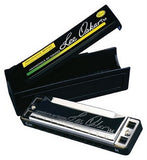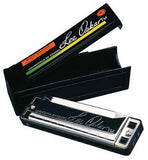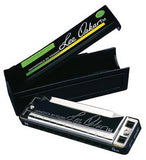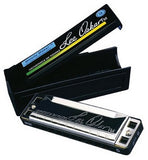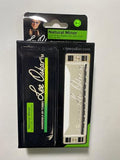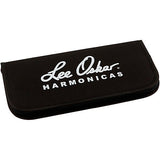Lee Oskar Harmonicas 1910, 1910N, 1910H, 1910MM includes Free USA Shipping
LEE OSKAR HARMONICA
1910 Major Diatonic
THE TRADITIONAL BLUES TUNING
Keys: LC, LF, LF#, LE, LD, G, Ab, A, Bb, B, C, Db, D, Eb, E, F, F#, High G The brand new keys of LD, LE, LF# AND LC are IN STOCK!
Model: 1910 – Labeled in 1st Position – Orange Label
The Major Diatonic is the standard Blues tuning and may be played in the 1st & 2nd Positions (Straight Harp & Cross Harp).
Understanding 1st & 2nd Positions
The Major Diatonic Harmonica was originally intended for playing simple Folk music of the nineteenth century and its notation layout was adequate for that purpose. The Major Diatonic harmonica is the most commonly used tuning for playing Blues, Rock, Country Folk & Jazz.
Several other manufacturers, using various names stamped on their cover plates, for marketing purposes, have the exact same notation layout as a Lee Oskar Major Diatonic harmonica.
The original style of playing, known as 1st Position (Straight Harp), is suitable for playing simple melodies, Folk music and various other types of music that call for melody lines, along with some chords. 1stPosition (Straight Harp), is still used by many players today, but due to its simplicity of sound, it is not as popular as 2nd Position (Cross Harp).
The evolution of music introduced Blues, Rock and Country and along with these new forms of music came the need for greater expression. Harmonica players began to experiment and found that when they primarily used the inhale (draw) notes, a different kind of sound was provided. This resulted in a new and more fluid style of playing, known as 2nd Position (Cross Harp). 90% of today’s players use 2nd Position for Blues, Rock, Country & Pop music.
2nd Position (Cross Harp), is a Blues scale that offers a more expressive and soulful sound. Many of the draw reeds can be bent (a technique used to change the pitch of a note).
1910N Natural Minor
Natural Minor harmonicas are designed to be played in the cross harp position. Lee Oskar Natural Minor harmonicas are labeled in their cross harp key - so if you're playing a song in A minor, you will need a Lee Oskar harmonica in A minor.
Model: 1910N – Labeled in 2nd Position – Green Label
Available in 12 Keys (Listed low to high):
Dm, Ebm, Em, Fm, F#m, Gm, Abm, Am, Bbm, Bm, Cm, Dbm
The Lee Oskar Harmonicas Natural Minor is a very useful harp that makes it much easier to play many musical genres that would otherwise be very difficult to play on the Standard harmonica tuning. Even if a player could master the highly advanced techniques that would be necessary to play certain melodies, one still would not have the chords and Minor scale notes that the Natural Minor provides.
Natural Minor harps have a very bluesy, soulful sound that’s perfect for playing Minor Blues, Reggae, Ska, Latin, Funk, R & B, Hip Hop.
This fabulous tuning is set up to play Minor music easily, without straining the lips, the lungs or the mind!
Natural Minors are designed to be played in 2nd Position (Cross Harp), not 1st Position (Straight Harp).
In 2nd Position, many of the draw notes can be bent and this allows for a much more expressive, fluid style of playing. 2nd Position is a very popular style used by most players for today’s music.
Comparison:
To make a Gm Natural Minor, we started with a C Major Diatonic (which plays in G in 2nd Position).
We flatted 5 reeds to make it into a minor tuned harmonica. (Shown in green below)
Then we labeled it in the 2nd Position key, Gm.
This tuning is designed to be played in 2nd Position (on the draw).
Notice how the available bends have changed.
Major Diatonic
Example: Key of C
Labeled in the 1st Position Key (shown in orange as #1 Blow) 
Natural Minors are key-labeled in 2nd Position.
This makes it easy to know which key of Natural Minor to use.
To play Minor music in the key of G minor, in 2nd Position, use a Gm Natural Minor harmonica. It’s that simple! Gm for Gm.
Natural Minors provide five flatted notes for playing Minor music.
Natural Minor
Example: Key of Gm
Labeled in the 2nd Position Key (shown in green as #2 Draw) 
1910H Harmonic Minor
Model: 1910H – Labeled in 1st Position – Yellow Label
Available in 12 Keys (Listed low to high):
Gm, Abm, Am, Bbm, Bm, Cm, Dbm, Dm, Eb, Em, Fm, F#m
The Harmonic Minor has been in use for a long time, as the traditional tuning for playing a wide array of international music.The Harmonic Minor tuning has a very soulful, Eastern European sound and was used for one entire side of Lee Oskar’s highly acclaimed first solo album.
This multi-cultural harmonica is intended to play traditional ethnic music that is important to the heritage of many cultures, such as: Minor Eastern European, Gypsy, Yiddish, Mediterranean, Middle Eastern, Asian and European/American Folk music, as well as various selections of Jazz and Classic Show Tunes.
1910MM Melody Maker
Model: 1910MM – Labeled in 2nd Position – Blue Label
Available in 9 Keys (Listed low to high):
C, D, Eb, E, F, G, A, Bb, High C
The Melody Maker™ makes it easier to play Standards and many other songs that can be difficult to play on a Major Diatonic, while producing a very expressive sound. The Melody Maker™ is the best harp available for playing single-note melodies. Because we changed the reeds in draw/inhale and blow/exhale, you can also play beautiful chords on this harp.
With its three altered notes, the Melody Maker™ is intended for playing Major scale melodies in 2nd Position (Cross Harp). In 1st Position (Straight Harp), you can play: Irish, Clave/Afro music. In 2nd Position (Cross Harp), you can play: R&B, Country, Reggae, Pop, Jazz, Latin.
(The Melody Maker™ is NOT recommended for Blues).
Comparison:
Major Diatonics are key-labeled in 1st Position.
However, when played in 2nd Position, the Key of the Harp is not the same as the key of the music.
Helpful key selection charts are packed inside every Lee Oskar Harmonica.
Melody Makers™ are key-labeled in 2nd Position.
This makes it easy to know which key of Melody Maker™ to use.
To play music in the key of G, in 2nd Position, use a G Melody Maker™. It’s that simple! G for G. The chart below shows the notes that have been altered from a Major Diatonic, allowing you to play melodies easily in 2nd Position.
Melody Makers™ provide a complete Major Scale starting from the #2 Draw.
G, A, B, C, D, E, F#, G (Do, Re, Me, Fa, So, La, Ti, Do)









